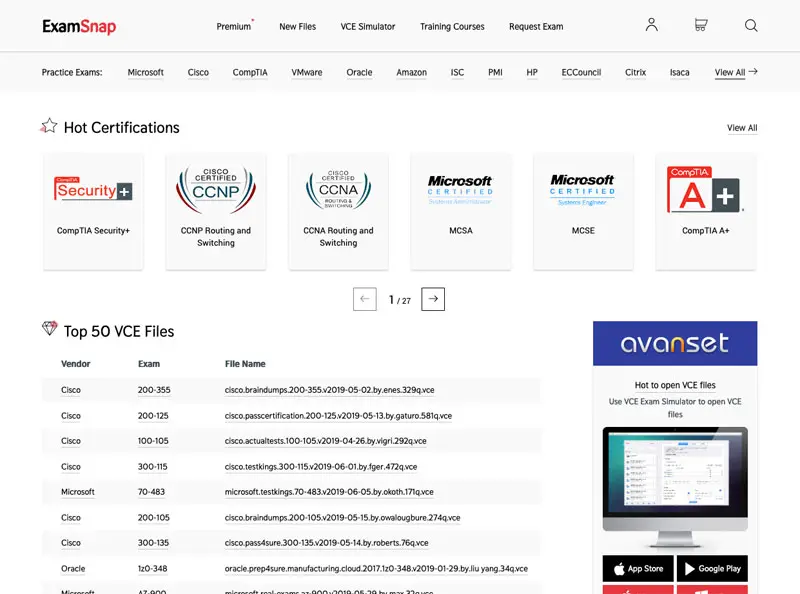Cisco is a leading vendor that offers some of the best certifications to professionals who intend to build their career in networking. Cisco offers five levels of certifications: Entry, Associate, Professional, Expert, and Architect. CCNP Routing and Switching is a professional-level certification offered to the network engineers who want to prove that they are able to configure, verify, plan, implement, and troubleshoot local as well as wide-area enterprise networks. In this article, you’ll learn about the exams candidates need to pass to get the CCNP R&S credential and find 5 great tricks that’ll help you to get certified on your first try.
CCNP Routing and Switching Certification Exams
Candidates need to pass 300-101 ROUTE, 300-115 SWITCH, and 300-135 TSHOOT to get the CCNP R&S certification. As a prerequisite, candidates are expected to have a valid CCNA Routing and Switching certification or any CCIE credential.
Below is an overview of the required tests.
300-101 ROUTE
Implementing Cisco IP Routing (ROUTE 300-101) is a qualifying exam of 120 minutes containing 45-65 questions. This exam validates that a certified individual has the skills and knowledge required to implement scalable and highly secure Cisco routers using advanced IP addressing and routing. This exam covers the following topics:
- Network Principles: This topic focuses on identifying the concepts of Cisco Express Forwarding, recognizing proposed changes to the network, and describing IP operations, TCP operations, UDP operations, and general network challenges.
- Layer 2 Technologies: This section tests the ability of the candidates to verify and configure PPP and describe Frame Relay.
- Layer 3 Technologies: This sections covers contents like identifying, configuring, and verifying IPv6 subnetting and addressing, explaining BGP attributes and best-path selection as well as configuring and verifying static routing, default routing, VRF lite, eBGP, and many more.
- VPN Technologies: This domain deals with describing DMVPN and EVN as well as configuring GRE.
- Infrastructure Security: This topic covers configuring and verifying device access control and router security features as well as describing IOS AAA.
- Infrastructure Services: This topic tests the candidates’ ability to configure and verify device management, SNMP, Network Time Protocol (NTP), and IPv4 Network Address Translation as well as describe IPv6 NAT and SLA architecture.
300-115 SWITCH
Implementing Cisco IP Switched Networks (SWITCH 300-115) is a 120-minute assessment containing 30-40 questions.This exam covers the following topics:
- Layer 2 Technologies: This domain covers topics like configuring and verifying switch administration, Layer 2 protocols, EtherChannels, spanning tree, and more.
- Infrastructure Security: This section focuses on configuring and verifying different switch security features and describing device security using Cisco IOS AAA with TACACS+ and RADIUS.
- Infrastructure Services: This section tests the individuals’ skills to verify and configure first-hop redundancy protocols.
300-135 TSHOOT
Troubleshooting and Maintaining Cisco IP Networks (TSHOOT 300-135) is a qualifying exam of 120 minutes containing 15-25 questions.This exam covers the following topics:
- Network Principles: This domain tests the hands-on skills of the candidates to use Cisco IOS troubleshooting tools and apply various troubleshooting techniques.
- Layer 2 Technologies: This topic focuses on troubleshooting switch administration, Layer 2 protocols, trunking, VLANs, spanning tree, EtherChannels, chassis virtualization, and aggregation technologies.
- Layer 3 Technologies: This section tests skills like troubleshooting IPv4/IPv6 subnetting and addressing, static and default routing, administrative distance, passive interfaces, VRF Lite, and many more.
- VPN Technologies: This topic focuses solely on troubleshooting GRE.
- Infrastructure Security: This domain tests the skills of the candidates to troubleshoot IOS AAA, device access control, and router security features.
- Infrastructure Services: This section covers contents like troubleshooting device management, SNMP, Network Time Protocol, IPv4 and IPv6 DHCP, SLA architecture, and more.
5 Tips to Pass Cisco CCNP R&S Certification Exams
Here are 5 tips that will help you pass CCNP R&S tests on your first try:
Create a Study Plan
Creating a study plan is one of the most important things to do before starting preparation for an exam. A well-structured study plan can help you to focus on complex topics and cover the whole syllabus within the shortest possible time. Before starting your preparation for CCNP R&S certification exams, make sure to familiarize yourself with the syllabus from the official website of Cisco.
This is necessary because the syllabus is subject to change, and Cisco can modify it at any time without any notice. After studying the syllabus, you need to arrange the topics in the order you want to study them. It is always better to start with a topic that seems the most difficult for you. Then, you can gradually move to the easier ones. Once your study plan is ready, you can start preparing for the exam.
Get Study Materials from Reliable Sources
There are tons of websites from where you can buy and download study materials for CCNP R&S certification exams. But it is always recommended to use only reliable sources. ExamSnap is one of the websites you can trust. ExamSnap has three premium bundles for the three different exams you need to pass to become certified. Besides, ExamSnap offers comprehensive training courses. The study materials found on ExamSnap are updated regularly and verified by professionals.
Develop Hands-on Skills
In CCNP R&S exams, questions are focused on both theoretical knowledge and practical skills. Having hands-on skills helps candidates to have a good command over all the topics as well as to answer questions concentrating on practical skills correctly. To gain hands-on skills and knowledge, candidates need to set up a personal lab and practice different tasks.
Take Practice Tests
When it comes to certification exams, there is no better way to prepare than taking as many practice tests as possible. Taking practice tests not only helps you to learn how to handle pressure and manage time but also gives you an idea of your overall level of preparedness.
Plan Which Exam You’ll Take First
Candidates need to pass three distinct exams to get the CCNA R&S certification. There is no certain order in which you should take the tests. However, it is recommended that you start with the one you are most comfortable with. Performing well in your first exam will boost your confidence level and help you to do better in the next ones.
Conclusion:
With a bit of determination and hard work, you can obtain your CCNA R&S certification without any struggle and get invaluable practical skills that will be very useful in the future. Remember, CCNA R&S is the credential that can help you build your dream career in networking. Good luck with your exams!













